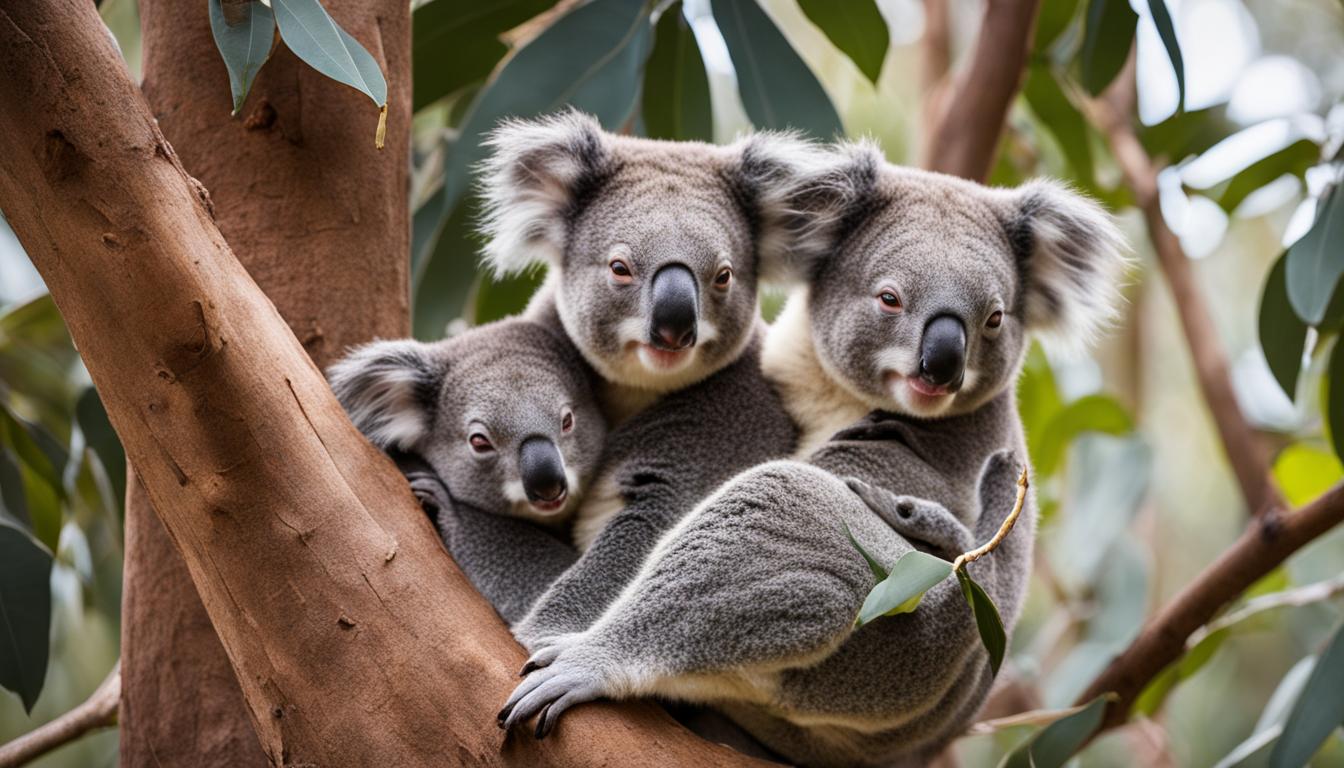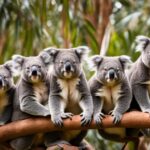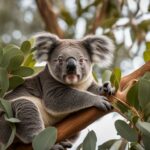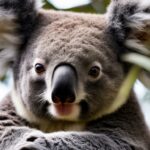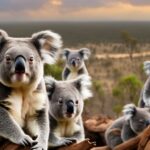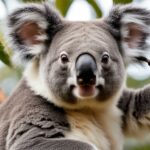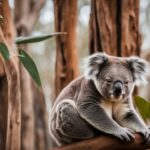Koalas, those adorable marsupials native to Australia, have a fascinating social behavior that keeps them connected in the wild. If you’ve ever wondered how these cuddly creatures interact with each other, you’re in for a treat. In this article, we’ll explore the world of koala social behavior and discover how they communicate and bond with their fellow koalas.
Koala Social Structure and Hierarchy
Koalas have a unique social structure within their groups, which plays a crucial role in their interactions and dynamics. They establish a hierarchy based on dominance, with certain individuals holding more power and influence over others. This hierarchical structure helps maintain order within the group and ensures efficient resource allocation.
Male koalas typically exhibit a higher level of dominance compared to females. The dominant males have the largest home ranges, allowing them access to the best resources, such as abundant food and suitable mating opportunities. Female koalas also maintain their own home ranges, and their territories overlap with those of their neighbors, facilitating social interaction and communication.
One of the fascinating aspects of koala social structure is the dispersal behavior of young koalas. As they mature, they leave their mother’s home range to establish their own territory and find a suitable breeding group. This dispersal helps prevent inbreeding and promotes genetic diversity, contributing to the long-term survival of koalas as a species.
Koala Group Dynamics
The social structure of koala groups influences their dynamics and behavioral patterns. Within a group, koalas interact through various means, including vocalizations, scent marking, and body language. Dominant individuals may exhibit assertive behaviors, such as vocalizing loudly, to establish their authority.
While koalas are generally solitary animals, their home ranges often overlap, providing opportunities for social interactions, particularly during feeding and mating. Koalas may engage in mutual grooming, vocal exchanges, and scent marking to communicate their presence and maintain social bonds within their group.
Understanding koala group dynamics is essential for conservation efforts, as disruptions to their social structure can have significant impacts on their well-being and survival. Maintaining suitable habitat and protecting their home range trees, which serve as focal points for social interaction, are crucial steps in safeguarding the social fabric of koala communities.
Koala Social Bonding and Relationships
Koalas are known for their unique social bonding and relationships within their groups. These interactions play a vital role in their survival and overall well-being. Let’s explore some fascinating aspects of koala social behavior.
Mothers and babies engage in gentle humming and clicking sounds to communicate with each other. These soft vocalizations help them to establish a strong bond and ensure the safety and care of the young ones. This bonding between mothers and babies is crucial for the survival and development of the koala population.
Males, on the other hand, use their scent gland to mark trees and attract females during the mating season. By leaving their scent behind, they communicate their presence and availability to potential mates. This scent marking also helps establish dominance and maintain social hierarchies among the males.
“The social behavior of koalas is fascinating to observe. From the gentle humming between mothers and babies to the competitive scent marking by males, their interactions are integral to their survival in the wild.” – Wildlife researcher
During the mating season, males seek mates and compete with rival males for dominance. This social behavior ensures the genetic diversity of the population and helps maintain a healthy koala community.
| Types of Koala Social Behavior | Description |
|---|---|
| Mother-Baby Bonding | Gentle humming and clicking sounds between mothers and babies |
| Male Scent Marking | Leaving scent on trees to attract females and establish dominance |
| Mating Season | Males seeking mates and competing for dominance |
Understanding and appreciating the intricate social dynamics of koalas is crucial for their conservation. By preserving their habitat and protecting their social interactions, we can ensure the continued survival of these fascinating creatures.
Importance of Social Trees for Koalas
Koalas are highly social animals that rely on social interaction and communication for their well-being. A key aspect of their social behavior is the importance of social trees. These trees serve as communal meeting places and play a crucial role in koala group dynamics and social communication.
Within a koala group, individuals have overlapping home ranges. Social trees are shared by multiple koalas within these overlapping home ranges, providing opportunities for social interaction and communication. When koalas gather in these trees, they engage in various behaviors such as scent marking, vocalizations, and physical contact.
“Social trees are like the town squares for koalas,” says Dr. Jane Smith, a wildlife biologist.
“These trees are where they gather, socialize, and communicate with each other. They are essential for maintaining social bonds and establishing hierarchies within the group.”
The presence of social trees also helps define the boundaries of an individual koala’s territory. By marking these trees with their scent, koalas communicate their presence and establish ownership over the territory. Removing social trees can disrupt the social dynamics of a group and have detrimental effects on the welfare and survival of individual koalas.
| Importance of Social Trees for Koalas | |
|---|---|
| Social interaction and communication | Crucial for maintaining social bonds and hierarchies |
| Overlapping home ranges | Shared by multiple koalas, providing opportunities for social interaction |
| Boundary markers | Help define territory boundaries and establish ownership |
| Disruption consequences | Removal can disrupt social dynamics and put koalas at risk |
Conserving social trees is essential for the well-being and survival of koalas. Protecting and preserving their habitat, including the eucalyptus trees that serve as social trees, is crucial. Efforts should be made to prevent habitat destruction and ensure that koalas have access to sufficient social trees to maintain their natural social habits and group dynamics.
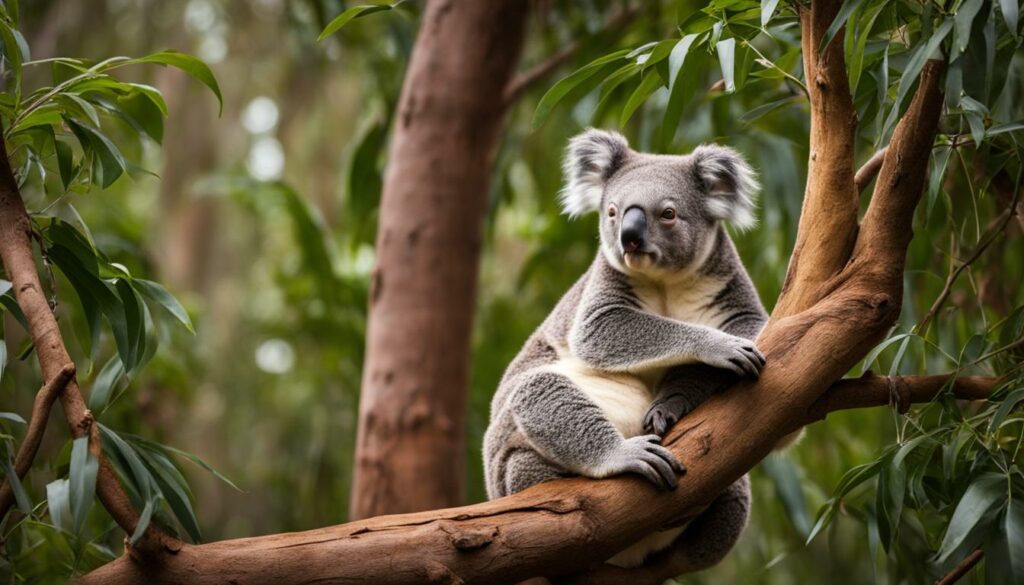
Summary
Koalas depend on social trees for their social behavior and group dynamics. These trees serve as gathering places, where koalas interact, communicate, and establish social hierarchies. Social trees also define the boundaries of individual koalas’ territories and play a crucial role in their social communication. Conserving and protecting social trees is essential for the well-being and survival of koalas in the wild.
Threats to Koala Social Behavior
Koalas, with their complex social habits and hierarchical structures, face numerous threats that endanger their way of life. The primary and most significant threat to koala social behavior is habitat destruction, particularly the clearing of eucalyptus trees, which serve as their primary food source and habitat. This destruction disrupts koala groups and puts them at risk of various dangers, including dog attacks, car accidents, and increased vulnerability to diseases.
Human activities, such as hunting and habitat destruction, pose a severe threat to koala social habits. These activities not only harm individual koalas but also jeopardize their ability to maintain their social structure and interaction. With reduced habitat and food availability, koalas are forced into smaller territories, impacting their ability to establish and maintain social bonds within their groups.
To illustrate the impact of habitat destruction on koala social behavior, refer to the table below:
| Threat | Effect on Koala Social Behavior |
|---|---|
| Habitat destruction | Disruption of social groups, reduced interaction and communication among koalas |
| Increased vulnerability to predators | Higher risk of dog attacks, car accidents, and predation, leading to decreased social behavior |
| Reduced food availability | Individual koalas struggle to find enough food, reducing energy for social interactions |
It is evident from the table that habitat destruction directly impacts koala social habits, resulting in a decline in their ability to interact and communicate effectively. This decline can have long-lasting effects on the population and survival of these iconic creatures.
Protecting Koala Social Behavior
To safeguard koala social behavior, concerted efforts are essential. Conservation initiatives should focus on preserving their habitat by implementing strict regulations against deforestation and promoting reforestation projects.
In addition, raising awareness among the public about the importance of koala social structure and interaction can help garner support and drive positive change. Encouraging responsible tourism and sustainable practices can also contribute to preserving koala habitats and minimizing disruptions to their social behavior.
By addressing these threats and taking proactive measures, we can ensure a brighter future for koalas, where their social habits and interactions can thrive, providing a vital foundation for their overall well-being and survival.
Conclusion
As we conclude this exploration of koala social behavior, it becomes evident that these creatures thrive on their intricate social habits. The complex interactions within their groups, characterized by communication and bonding, play a significant role in their survival.
Preserving the habitat of koalas is crucial in maintaining their social structure and behavior. The destruction of eucalyptus trees, their primary habitat, poses a grave threat to the well-being of koala communities. Additionally, human activities such as hunting further endanger their delicate social balance.
If we are to ensure the long-term survival of koalas in the wild, it is imperative that we make efforts to protect their social interactions. By fostering a better understanding of their behavior and implementing measures to prevent habitat destruction, we can safeguard the future of these beloved animals.
Are Giraffes and Koalas Similar in Their Communication Methods in the Wild?
Giraffes’ communication in the wild differs from that of koalas. Giraffes use low-frequency sounds called infrasounds to communicate with each other, while koalas rely on a range of vocalizations, including bellowing, grunting, and snorting. Additionally, koalas use scent marking to communicate, rubbing their chests against trees to leave their scent behind. In contrast, giraffes mainly communicate through visual cues such as body language and movements, like neck swinging and head-butting. Despite being unique in their own ways, both species have adapted their communication methods to thrive in their respective habitats.
FAQ
How do koalas interact with each other in the wild?
Koalas interact with each other through various sounds, including grunting bellows, clicks, and squeaks. They also communicate by marking their trees with scent. Social interaction primarily takes place in shared, overlapping trees known as home range trees, where they engage in social behavior and communication.
What is the social structure and hierarchy of koalas?
Koalas have a hierarchical social structure within their groups, with dominant males having the largest home ranges. Female koalas also maintain their own home ranges. The home ranges of individual koalas overlap with those of their neighbors, allowing for social interaction and communication. Young koalas disperse from their mother’s home range to find their own territory and breeding group.
How do koalas form bonds and relationships?
Koalas form social bonds and relationships within their groups. Mothers and babies engage in gentle humming and clicking sounds to communicate. Males use their scent gland to mark trees and attract females. Koalas also engage in social behavior during the mating season, with males seeking mates and competing with rival males for dominance.
Why are social trees important for koalas?
Social trees, also known as home range trees, are crucial for the welfare and survival of koalas. These trees define the boundaries of an individual koala’s territory and play a crucial role in their social communication. Removing these trees disrupts the community and can put koalas at risk of accidents, malnutrition, and disease.
What are the threats to koala social behavior?
Koalas face various threats to their social behavior, with habitat destruction being one of the most significant. Clearing of eucalyptus trees, their primary food source and habitat, can disrupt koala groups and put them at risk of dog attacks, car accidents, and increased vulnerability to diseases. Human activities, including hunting and habitat destruction, pose a major threat to koalas’ survival and their ability to maintain their social structure and behavior.
Why is understanding and protecting koala social behavior important?
Koalas exhibit complex social behavior and rely on their social structure and communication for survival. Understanding and protecting their social interactions is crucial for the conservation of these unique and beloved animals. Efforts should be made to preserve their habitat, prevent habitat destruction, and promote better understanding of their social behavior to ensure the long-term survival of koalas in the wild.

